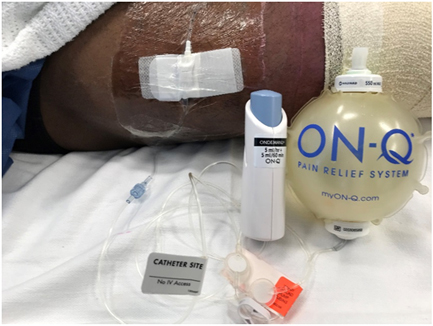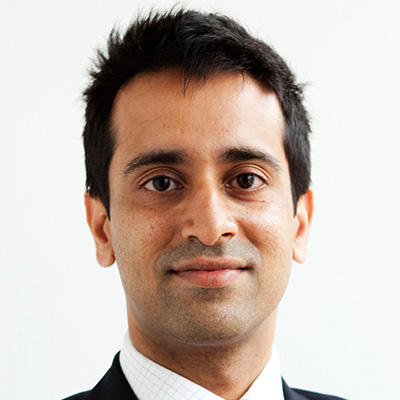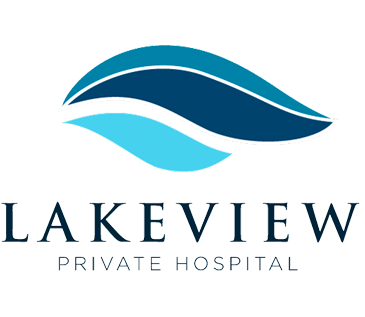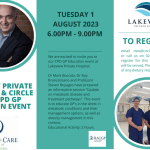Successful pain relief following total knee replacement
Dr Bu Balalla
BSc(Med) MBBS FRACS(Orth) FA(Orth)A
Dr Bu Balalla explains how surgeons and anaesthetists at Lakeview Private have been working closely together to introduce the latest best-practice analgesic techniques.
 Total knee replacement has traditionally been a procedure associated with significant postoperative pain. Recent advances in postoperative pain research, specifically, the multimodal approach to pain management, has greatly improved pain control after knee replacement surgery. The multimodal approach to postoperative pain management utilises various analgesic modalities at lower thresholds rather than relying on high dose single modality opioid regimens. This approach has been shown to achieve superior and more reliable pain control with a reduced side effect profile.
Total knee replacement has traditionally been a procedure associated with significant postoperative pain. Recent advances in postoperative pain research, specifically, the multimodal approach to pain management, has greatly improved pain control after knee replacement surgery. The multimodal approach to postoperative pain management utilises various analgesic modalities at lower thresholds rather than relying on high dose single modality opioid regimens. This approach has been shown to achieve superior and more reliable pain control with a reduced side effect profile.
Surgeons and anaesthetists have been working together closely at Lakeview Private Hospital to introduce the latest best-practice analgesic techniques. This involves a combination of Intraoperative spinal anaesthesia and periarticular injections combined with multimodal oral medications and a continuous adductor canal catheter.
Spinal anaesthesia for knee replacement has been shown to reduce DVT rates, lower cardiovascular stress when compared with general anaesthesia, and improve postoperative pain.Patients receiving spinal anaesthesia had a lower rate of wound infection, blood transfusions, and overall complications, with lower lengths of hospital stay.
Periarticular injections are performed by the surgeon during the procedure. This mix of medications is delivered into the soft tissues around the knee, particularly into the posterior capsule and the inner aspect of the knee. The injection mixture contains local anaesthetic, adrenaline, ketorolac, and several other medications depending on the surgeons’ choice Patients receiving periarticular injections have demonstrated lower pain scores, opioid consumption and postoperative nausea/vomiting and an improved range of motion.
The oral multimodal analgesia incorporates a combination of opioid and non-opioid analgesics, anti-inflammatory drugs, paracetamol, and gabapentinoids. The aim is to
Improve pain control via medications that act via different pathways, reducing side effects while minimizing systemic narcotic consumption. Once the patient is discharged, these medications continue, and are weaned gradually.
Adductor canal blockade is one of the latest techniques in analgesia for knee replacement surgery. It selectively blocks sensory nerves with minimal if any motor involvement. It results in excellent pain relief over the inner aspect of the knee, which is often very sensitive after surgery. At Lakeview Private Hospital we use a continuous catheter, which is left in place for around 3 days. This allows the patient to walk without weakness, but significantly lowers opiate consumption in the first 72 hours. Our nursing staff are specially trained in the management of these catheters, and patient feedback has been extremely positive.
Successful pain relief following total knee replacement requires a multidisciplinary effort, involving the surgeon, the anaesthetist, and nursing staff, using a complex multi-pronged approach. At Lakeview Private Hospital, the focus is on delivering the best possible pain relief and outcomes for our patients.

Dr Bu Balalla
BSc(Med) MBBS FRACS(Orth) FA(Orth)A
Orthopaedic surgery
Arthroscopic knee surgery, ACL and multi ligament reconstructions, and knee replacements
Dr Balalla is an orthopaedic surgeon with a subspecialty focus on knee surgery. He specialises in computer-guided total and uni knee replacement, tissue-preserving ACL reconstruction and complex knee trauma.Dr Balalla graduated from Medicine at the University of New South Wales in 2001 and commenced his basic surgical training with the Royal Australasian College of Surgeons in 2003. He was selected for the Australian Orthopaedic Association’s Orthopaedic Training Program in 2007.





